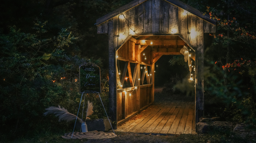
These rustic branch bottles have all the attributes that make a cabin project great: They’re woodsy, fun to make and darn near free. And they are useful for so many things.
The bottles will hold all sorts of small things, from spices to thumbtacks. Without corks, they look terrific on the table as toothpick holders; on the window sill holding dried wildflowers; or on the mantle stuffed with matchsticks. Or, with a shallow hole, a limb can become an elegant tea-light pillar.
This project has just two components: the body (made from a seasoned branch or sapling log) and the bark-top cork.
The branch bottle is about 2 1/2" in diameter. But you can make your bottle whatever size you like. Natural-top corks are available from less than 1 inch to fully 6 inches across. As an alternative, you can whittle or turn wood stoppers to fit.
The containers are formed by boring out the center of the branch sections. I recommend using a Forstner bit mounted in a drill press. For the bottle shown, I used a 1 5/8" diameter bit to accommodate corks that taper from 2 inches at the top to 1 1/2" at the base.
The bottles will hold all sorts of small things, from spices to thumbtacks. Without corks, they look terrific on the table as toothpick holders; on the window sill holding dried wildflowers; or on the mantle stuffed with matchsticks. Or, with a shallow hole, a limb can become an elegant tea-light pillar.
This project has just two components: the body (made from a seasoned branch or sapling log) and the bark-top cork.
The branch bottle is about 2 1/2" in diameter. But you can make your bottle whatever size you like. Natural-top corks are available from less than 1 inch to fully 6 inches across. As an alternative, you can whittle or turn wood stoppers to fit.
The containers are formed by boring out the center of the branch sections. I recommend using a Forstner bit mounted in a drill press. For the bottle shown, I used a 1 5/8" diameter bit to accommodate corks that taper from 2 inches at the top to 1 1/2" at the base.
Tools and Materials:
- Dry limb or sapling trunk sections, approximately 2 1/2" in diameter
- Bark-top cork stoppers with a 1 1/2" bottom diameter
- Sandpaper, assorted grits
- Spray polyurethane or finish of choice
- Hand saw or band saw
- Drill press
- Forstner bit, 1 1/2" to 1 5/8" diameter
- Forstner bit extension
- Hand screw clamp and C-clamp
- Finish sander or sanding block
- Combination square and tape measure
- Pencil
- Compass
- Awl
- (Optional) Drill-mounted sanding drum with extension, 1 1/2" diameter or smaller
- Appropriate safety gear, including eye, ear and lung protection
1. Cut limbs to length.
Choose a dry, seasoned branch and saw it to length. A simple cradle made from scrap wood and clamped to a workbench will steady the limb while you cut.
2. Mark branch centers.
Place an awl mark on top of the branch at the approximate center. The objective is to leave a wall of nearly even thickness around the bored-out center. I find that a compass, set to the same radius as the drill bit to be used, is useful for visualizing this.
3. Set up a clamp for drilling.
Large-diameter drill bits create significant torque and, therefore, danger. If they catch or bind, they can easily rip a branch from your grip. If you’re lucky, only your work will be damaged. For this reason, it is important to clamp your work while you drill. I use a wood-jawed hand screw to hold the branch sections. Although the clamp grips tightly, its jaws are gentle on the logs. Secure the hand screw to the drill-press table with a C-clamp.
4. Bore the hole.
Forstner bits excel at cutting clean, flat-bottom holes. But they tend to be quite short, which limits the capacity of your vessel to a few inches. To drill deeper holes, use a Forstner bit extension. Fasten the extension to your drill bit, and mount the assembly in your drill press. Adjust the drill press to leave 1/2" to 3/4" of material at the bottom of the bottle. With the drill bit centered over the work piece, tighten the hand screw. Then bore your hole.
Take your time and let the bit do the work. Back out the bit frequently to clear debris from the hole and allow the bit to cool. Drilling into dry end grain can heat up the bit quickly, particularly if you are using hardwood. If you find the bit overheating, take breaks to let it cool or quench it occasionally in a can of water.

5. Sand top, bottom and inside.
With rustic projects like these, sanding is optional. To sand the tops and bottoms of the bottles, use a finish sander or sanding block. Work from rougher sandpaper, 100 grit or 120 grit, through successively finer grades, to 180 grit or 220 grit. If you like, you can sand the interior with a drill-mounted sanding drum. A drill bit extender, made for a 1/4" shank, will provide extra reach. For the bottle shown, I sanded the top and bottom, but not the inside.
6. Apply finish.
Finish as you like, following the manufacturer’s directions. The branch bottle was finished with just spray polyurethane. For the peeled-juniper match holder, I first used a shellac sanding sealer to enhance the wood, and then gave it a few coats of semi-gloss polyurethane.
Project guy Raj Chaudhry uses branch bottles for everything from game pieces to spare keys.
Project guy Raj Chaudhry uses branch bottles for everything from game pieces to spare keys.










